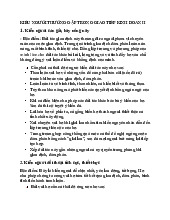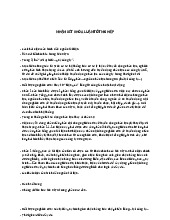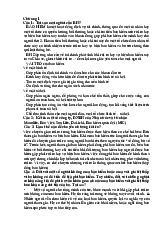














Preview text:
lOMoAR cPSD| 48302938
Farm household economics
Lesson 4. Household’s economic-socio behaviours 2021 Luu Van Duy
Department: Agricultural economics and policy 1
4.1 The profit maximising peasant Contents
Peasants and economic efficiency Peasants and risks
Peasants and strenuousness 2 lOMoAR cPSD| 48302938 What do peasants concern?
Profit, income or economic efficiency?
Or satisfy family’s social needs … 3
What is economic efficiency? Technical efficiency Allocative efficiency Economic efficiency 4 lOMoAR cPSD| 48302938 Technical efficiency
Technical efficiency: Output /input
It is the maximum attainable level of output for a given
level of production inputs, given the range of
alternative technologies available to the farmer.
TPP1 obtains production (yield) much more than TPP2 with all input levels
Those famers use TPP1 obtain technical efficiency
comparing to TPP2 applied farmers. 5
Allocative efficiency (Price efficiency)
Technical efficiency (Cont.) Labour 6
Refers to the adjustment of inputs and outputs to
reflect relative prices, the technology of production already having been chosen.
One input – one output: MVP = MFC; (MR = MC)
Many inputs – one output: MPP1/P1 = MPP2/P2 = ... lOMoAR cPSD| 48302938
One input – many outputs: MVP(Y1)= MVP(Y2)= ...
MVP: Marginal value product MFC: Marginal factor cost 7
Allocative efficiency - Price efficiency (Cont.) Allocative efficiency:
D: none technical and allocative efficiency C: allocative
efficiency obtained but none technical efficiency
B: technical efficiency obtained, none-allocative efficiency
A: Obtains both technical efficiency and allocative efficiency
Economic efficiency = technical efficiency x Alloca ti ve efficiency 8 lOMoAR cPSD| 48302938 Technical efficiency and Obtains boths none allocative efficiency
Farm household’s behaviour with economic profit maximising
Allocative efficiency but none technical efficiency
Decision making in choosing needed outputs for None boths
production (which outputs should be produced?): Outputs – outputs
Decision making in choosing needed inputs for
production (How to produce?): inputs – outputs
Decision making in choosing inputs (How to produce? ): Inputs – input Labour 10 9
Decision making in choosing needed outputs for production
(which outputs should be produced?): Outputs – outputs
Identify optimal production quantity for competative outputs:
∆Y2 x PY2 = ∆Y1 x PY1 (1)
or ∆Y1/∆Y2 = PY2/PY1 (2) Of
which, ∆Y1/∆Y2: proportions of
quantity of substitutional outputs PY2/PY1: Price proportion of substituted outputs Yield lOMoAR cPSD| 48302938 11
Decision making in choosing needed inputs for
production (How to produce?): inputs – outputs
Decision making in choosing needed inputs for
production (How to produce?): inputs – outputs
Relationship between inputs and outputs Y = f (Xi, T, E)
Y = f (X1/ X2, X3...Xn, T, E)
Rule of gradually decrease marginal productivity 12
In agriculture, agricultural outputs (Y) depends on many factors:
quantity and quality of inputs (Xi): land, fertilizers, feed,
pesticide,...technologies (T), environment (E). It is reflected by the production function: Y = f(Xi, T, E)
Focus on: Y = f(X1/X2, X3,….Xn, T, E)
Rule of gradually decrease marginal productivity: When one kind of
input is gradually increased with fix other inputs leading to increasing
in agricultural outputs, but production level will be reached to maximum point then reduce. lOMoAR cPSD| 48302938 13
Decision making in choosing inputs (How to
produce?): Inputs – inputs
Identify input quantity for optimal outputs:
Quantity of input investment is optimal at: MR = MC
or ΔY*PY = ΔX*PX (1) (Added value product = Added factor cost) or ∆Y/ ∆X = P X /P Y (2) 14
Yield (Y) depends on two inputs including X1 (seed)
and X2 (labour), reflect by the following function: Y = f(X1, X2/X3,….Xi)
Quantity of inputs investment is optimal at: proportions
of quantity of substitutional inputs = Price proportion of substituted inputs or , - ΔX2/ΔX1 = PX1/PX2 lOMoAR cPSD| 48302938 15
What should we do to strengthen farm household economics
Impacting factors of farm household’s economic efficiency Applied technology
Farmer’s knowledge and skills
Infrastructure for production Market Policies 16
Build high quality of rural infrastructure: irrigation, rural communication….
Strengthen agricultural extension
Increase investment of education Credit support
Cooperation among farm households and with enterprises lOMoAR cPSD| 48302938 17 What are risks?
4.2 Peasants and risks Definition of risk?
Kind of risks peasants are facing?
Peasant’s behaviors with the risks
What should peasants do to limit the risks 18 Uncertainty
Uncertainty is a situation where it is not possible to attach
probabilities to the occurrence of events.
Decision makers and peasants do not calculate the expected occurrence of events
Popularly happen in developing countries due to lack of information
In tropical zone is more serious due to erratic climate and climate changes.
Impact on the rich and the poor is also different Risks lOMoAR cPSD| 48302938
Risk is restricted to situation where probabilities can be attached to
the occurrence of events which influence the outcome of a decision-making 19
Differentiate between objective and subjective risk s
Objective risks: Risks are not depended on people’s expectation.
People can calculate the probability of the occurrence of un certain events.
Subjective risks: Risks are depended on each individual’s
expectation. Every people have different perceptions abou t the
likelihood of occurrence of event leading to different beha viour. For example:
- There are two young people such as NO and YES who are
preparing for their pesticide uses. Both of them can be faced with
risks of pesticide uses . 20 lOMoAR cPSD| 48302938 Yes In the paddy field No “Pesticide is very “I never use protection toxic. I am absorbed facilities during pesticide if I do not pesticide using and it
protect by myself” not impact. This time is the same” 21
Perception -> Behaviour -> Outcomes Yes No Risks can be Risks can be occurred not occurred Actions to Do nothing reduction of risks Do not face Face risk risk 22
What risks peasants are facing? lOMoAR cPSD| 48302938 Climate and weather risks Market risks Institutional risks Human risks Political risks Financial risks …
Students give examples of each type of risk lOMoAR cPSD| 48302938 23
Peasant’s behavior with the risks (Cont.)
Peasant’s behavior with the risks ? Giá trị sản lượng 24 Type of No risk Risk Type of investment behaviour X 1 Gain: ab Loss: bj Risk acceptance X 2 Gain: ce Gain: de Risk protection X e Gain: fh Loss: hi Neutral behavior lOMoAR cPSD| 48302938 25 Work in groups:
Point out information needed to collect in order to examine these
following topics: Assessment of economic efficiency
What should peasants do to control the risks?
Climate and weather risks? Market risks? Institutional risks? Human risks? Political risks? Financial risks? 26
(1) Assessment of economic efficiency of pig raising by
households in Trau Quy ward, Gia Lam district, Hanoi
(100 head per production cycle)
(2) Assessment of economic efficiency of brick
production by households in Bac Giang province (one million unit per year)
(3) Assessment of economic efficiency of fresh bud tea
by farmers in Thai Nguyen province (1 ha in 10 years)
(4) Assessment of economic efficiency of business of
rental rooms for students in the Trau Quy ward, Gia Lam
district, Hanoi (50 units in 10 years) lOMoAR cPSD| 48302938 27
Tiêu chí chấm: (1) Đầy đủ các khoản chi phí, (2)
Đầy đủ các khoản thu, (3) áp dụng công thức,
(4) ra kết quả cuối cùng
MI= VA-thuế-khấu hao TPr=TR-TC các loại
phí-lao động TR=P*Q thuê (nếu có) TC=FC+VC VA=GO-IC
FC chi phí cố định (Fix GO=P*Q cost)
IC=tổng chi phí vật chất
VC: Chi phí biến
đổi bằng tiền (giống, phân bón, thú y, bảo vệ thực -> TPr/lao động
vật, thức ăn chăn nuôi) TPr/vốn -> MI/lao động TPr/đất đai MI/vốn MI/đất đai 28




